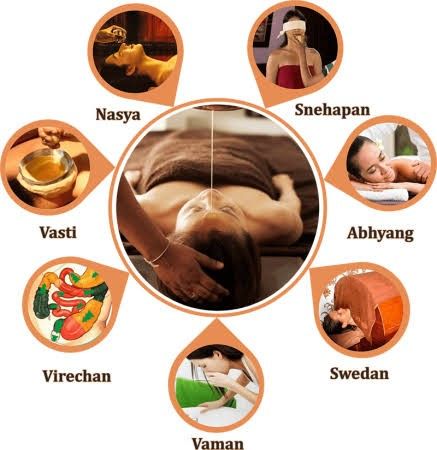What is Panchakarma Treatment?
Panchakarma treatment means “five actions” (Pancha = five, Karma = actions). It is a set of five therapeutic procedures designed to eliminate toxins (ama) from the body and restore the natural balance of the three doshas—Vata, Pitta, and Kapha. Originating from ancient Ayurvedic texts like the Charaka Samhita, the primary purpose of Panchakarma is not just detoxification, but also profound rejuvenation and bringing the body’s fundamental energies back into harmony. It’s a comprehensive approach to health, addressing the root causes of disease rather than just managing symptoms.

The Panchakarma Process: Stages of Treatment

Purva Karma (Preparation)
- Snehana (Oleation): This involves both internal and external application of medicated oils or ghee. Internal oleation helps loosen toxins from the cells, while external oleation (therapeutic massages) lubricates channels and relaxes the body.
- Swedana (Therapeutic Sweating): After oleation, controlled sweating is induced using herbal steam baths or fomentation. Swedana opens up channels, further liquefies toxins, and enhances circulation, preparing the body for the main cleansing procedures.
Pradhana Karma (Main Procedure)
- Vamana (Therapeutic Emesis): Induced vomiting to eliminate Kapha toxins from the respiratory and upper gastrointestinal tracts.
- Virechana (Therapeutic Purgation): Medicated purgation to eliminate Pitta toxins from the small intestine, liver, and gallbladder.
- Basti (Medicated Enema): Herbal enemas to cleanse the colon and eliminate Vata toxins, addressing various chronic conditions.
- Nasya (Nasal Administration): Administration of medicated oils or herbal preparations through the nasal passages to cleanse and nourish the head region, benefiting conditions above the clavicle.
- Rakta Mokshana (Bloodletting): (Less commonly practiced today and only under strict medical supervision) Used to purify the blood of toxins in specific conditions.
Paschat Karma (Post-treatment Care)
- Diet Regulation: A specific dietary regimen (Samsarjana Karma) is followed, gradually reintroducing foods to restore digestive fire (Agni).
- Herbal Supplements: Specific herbal formulations are prescribed to support rejuvenation, strengthen tissues, and maintain dosha balance.
- Lifestyle Recommendations: Guidance on daily routines (Dinacharya), seasonal routines (Ritucharya), mindfulness, and meditation to integrate the benefits of Panchakarma into everyday life.
Key Benefits of Panchakarma
- Deep detoxification of body and mind: Eliminates accumulated toxins that contribute to chronic diseases.
- Strengthening of the immune system: By removing blockages and nourishing tissues, it enhances the body’s natural defense mechanisms.
- Slowing down aging and increasing vitality: Promotes cellular regeneration and improves overall energy levels.
- Improved digestion, sleep, and mental clarity: A balanced digestive fire leads to better nutrient absorption, while detoxification calms the nervous system, improving sleep and cognitive function.
- Hormonal balance and reproductive health: Helps regulate hormonal imbalances, benefiting conditions like PCOS and supporting fertility.
- Emotional release and clarity: The process can facilitate the release of emotional blockages and bring about greater emotional stability.
Who Should Consider Panchakarma?
- Ideal candidates: People grappling with chronic lifestyle diseases (e.g., hypertension, diabetes), persistent stress, chronic fatigue, or unexplained malaise.
- Preventive care: Healthy individuals can undergo Panchakarma annually or bi-annually to maintain balance, prevent disease, and boost overall well-being.
- Those with dosha imbalances: Individuals experiencing symptoms related to an aggravated Vata, Pitta, or Kapha dosha can find significant relief and rebalance.
- Conditions it may help: Conditions like Irritable Bowel Syndrome (IBS), Polycystic Ovary Syndrome (PCOS), chronic joint pain, various skin issues, and mental health challenges like anxiety and depression often respond well to this Ayurvedic detox therapy. It is a powerful dosha balancing therapy and one of the most effective Ayurvedic treatments for immunity.
Why Choose Ayurvedgram for Panchakarma?
- Expert Ayurvedic doctors and therapists: Highly qualified practitioners who customize each Panchakarma plan to your unique constitution and health needs.
- Authentic, personalized treatments: A commitment to traditional Ayurvedic principles, ensuring genuine and effective therapies tailored for you.
- Serene healing environment: A tranquil and supportive atmosphere conducive to deep healing and relaxation.
- Use of high-quality herbs and oils: Sourcing only the finest, most potent herbal formulations and oils for maximum therapeutic benefit.
In an age where health challenges are increasingly complex, reconnecting with time-tested healing modalities like Panchakarma offers a path to profound well-being. It’s not just a treatment; it’s a journey towards self-discovery and holistic health.


 医療観光
医療観光
